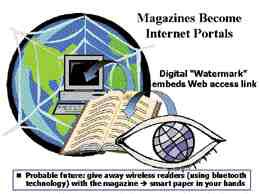
Features
Research & Innovation
The Future of Publication Papers: Impacts of the Internet
Though the publication papers community (magazines, newspapers, catalogues) may view the Internet invasion with apprehension, people continue to enjoy using their products. The Internet offers a diffe...
September 1, 2000 By Pulp & Paper Canada

Though the publication papers community (magazines, newspapers, catalogues) may view the Internet invasion with apprehension, people continue to enjoy using their products. The Internet offers a different experience to consumers and it is not the either/or proposition that many of the tech-push community cite. The unfolding real world indicates that paper and the Internet are not mutually exclusive; there are significant
mutual benefits for both media. The issue for the paper industry is to find the synergies, to aggressively promote where paper fits, and not be spooked by “paperless proclamations”.
In spite of the continuing mantra from the techie community about paper’s demise, people still like using it. Magazines, catalogues and newspapers show no signs of any major decline in readership and ad spending remains strong. High readership is synonymous with education and disposable income, both of which are increasing. High use of paper (and other media) is also driven by dramatic increases in information, more diversity, more customization and more choices — all consequences of accelerating information technologies and the Internet. However, the new consumer is no longer a passive recipient of corporate marketing, but is proactive, informed, empowered and demanding of products and their providers.
The Internet is a new medium. It gives access to virtually unlimited information and allows connections and sharing in different ways. The Internet competes for consumers’ attention and their time budget. However, just as radio did not replace newspapers, TV did not replace movies, VCRs have not replaced movie theatres and so on down the line, the Internet will not replace other media, including paper. On the contrary, because the Internet is generating new business models, new ways of buying and selling, new ways of communicating, new ways for information searching, there is more stuff out there — a higher “information flux.” This requires an increased use of media to process. The new space and diversity that the Internet has created needs explaining, reporting and analyzing. This explains the proliferation of special-interest magazines and new supplements to newspapers. However, accessing information from the Internet is a different experience from accessing information from a magazine, newspaper or a print-on-demand document. The paper experience is biased toward human emotions, whereas, the Internet human interface is more of a pragmatic impersonal technology-centered experience.
What seems to be frequently overlooked is that paper products and the Internet are not mutually exclusive, but can and should be synergistic. To be sure, there will be some paper product segments where the pragmatic consumer-use attributes are made obsolete by electronic/Internet systems (e.g., business forms, some forms of classified ads, directories and other information-rich products). However, the leisure, recreational, special interest, consumer-use attributes of paper products continue to compete and maintain their market share alongside the electronic alternatives. A recent innovation will allow magazines to become Internet portals! Other examples of synergy within the two media are companion websites for newspapers and catalogues, TV shows morphing into magazines and vice versa. The future scope of synergy will be limited only by imagination.
In a continuing quest for consumers’ attention, advertising carries most of the freight for publication papers and the Internet. The advertiser is looking for reach and target, for which there is continuing technology development. The electronic media is capable of directly targeting individual consumers, but there will likely be a privacy backlash, not to mention electronic filtering software (compare the TV zapper which boosted paper ad spending in the 80s). Targeting with paper media is less intrusive. Many paper products are also chosen by the consumer for their content (e.g., the special-interest magazine, the catalogue or the local newspaper). This provides the critical first level of targeting for the advertiser. In electronic forms, the predominance is for ad-push to the consumer, much like the direct mail and coupon paper products. Demanding consumers do not appreciate this in-your-face approach. Furthermore, ad spending on the Internet, which is still relatively small and of questionable effectiveness, seems due for a major “correction.”
The paper advantage can be summarized as appealing to the emotional quality needs of consumers. These can be “quiet” leisure, sharing, security, diversity, creativity and credibility. The electronic forms appeal more to the need for interactive behavior, information access, searching, storing.
Why is this important?
The paper industry must recognize that there are underlying synergies and opportunities for paper in an electronic and Internet world, which will demand new quality attributes, customization, branding and partnerships. There will always be the risk that paper use can diminish vis–vis historical use patterns, as paper competes for consumer attention with new media choices in an expanded information pie. The focus is to define and vigorously promote the paper advantage as a medium choice for advertisers and consumers. Furthermore, in a growing market for increasing disposable income and unlimited choices, a more demanding consumer will not settle for second-best.
Alan R. Procter can be reached at a.r._procter@telus.net for more information, visit www.futureviews.net
Print this page